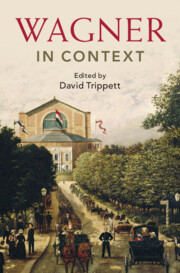Book contents
- Wagner in Context
- Composers in Context
- Wagner in Context
- Copyright page
- Contents
- Illustrations
- Musical Examples
- Contributors
- Acknowledgements
- Abbreviations
- Introduction
- I Place
- II People
- III Politics, Ideas, and Bodies
- IV Life, Language, and the Ancient World
- Chapter 23 Wagner’s Finances
- Chapter 24 Wagner’s Apprenticeship
- Chapter 25 Wagner’s Mendacious Humanism: Wagnerian Rhetoric between Nature and the Human
- Chapter 26 Declaiming Wagner: Between Genesis and Historical Performance Practice
- Chapter 27 The German Study of India and Buddhism
- Chapter 28 Greek Drama in Its Nineteenth-Century Reception
- V Music and Performance
- VI Reception
- Further Reading
- Select Bibliography
- Index
Chapter 27 - The German Study of India and Buddhism
from IV - Life, Language, and the Ancient World
Published online by Cambridge University Press: 14 March 2024
- Wagner in Context
- Composers in Context
- Wagner in Context
- Copyright page
- Contents
- Illustrations
- Musical Examples
- Contributors
- Acknowledgements
- Abbreviations
- Introduction
- I Place
- II People
- III Politics, Ideas, and Bodies
- IV Life, Language, and the Ancient World
- Chapter 23 Wagner’s Finances
- Chapter 24 Wagner’s Apprenticeship
- Chapter 25 Wagner’s Mendacious Humanism: Wagnerian Rhetoric between Nature and the Human
- Chapter 26 Declaiming Wagner: Between Genesis and Historical Performance Practice
- Chapter 27 The German Study of India and Buddhism
- Chapter 28 Greek Drama in Its Nineteenth-Century Reception
- V Music and Performance
- VI Reception
- Further Reading
- Select Bibliography
- Index
Summary
Wagner’s fascination with Indian literary culture followed a similar impulse from Schopenhauer, Friedrich Schlegel, and Karl Köppen, among others, as part of an ‘oriental renaissance’. The German construction of India, after William Jones’ pioneering work on Sanskrit Upanishads while in the East India Company, accrued around the promise of philological routes to the origins of world culture, demonstrating a primordial link between Latin, Greek, and Sanskrit. It also offers a context for Wagner’s passion for Buddhism, as distinct from Vedic Hinduism, and the figure of the Buddha, most notable in Die Sieger and Parsifal, but also traceable in the Ring.
- Type
- Chapter
- Information
- Wagner in Context , pp. 267 - 274Publisher: Cambridge University PressPrint publication year: 2024

